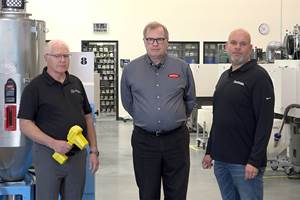Dri-Air Readies Its Dryers for Industry 4.0 Today, and Industry 4.0 in the Future
Industry 4.0 is very much a work in progress, with key standards and protocols still in development, but that’s not stopping Dri-Air Industries from jumping into the technology.
At NPE2018, the company is introducing the Dri-Air Dryer 4.0 (Booth W971) to give its customers a resin-drying technology that’s up to speed with what 4.0 means today and one that can adapt to where the industry-wide movement is headed in the future. Charlie Sears, Dri-Air’s president, says the Dri-Air Dryer 4.0 utilizes the OPC-UA protocol, developed by European plastics machinery association, Euromap, and intended to be the common language that all these newly conversant machines will speak in the future. But Sears, who has been with Dri-Air since 1985, and in the industry longer, brings a little perspective to the 4.0 hype.
“We have used the OPC-UA protocol,” Sears says, “but there is more to it.” Sears notes that Euromap is in the process of setting up the complete protocol, including, ultimately, where specific process information is located and what information is included, but when that actually occurs is as yet unknown. “Unfortunately we do not see this happening soon,” Sears says, “so the progress of 4.0 will be slowed down.”
That said, whenever these protocols are fully developed and implemented, Dri-Air is in, Sears says. “Industry 4.0, or whatever you want to call it, will be fully developed during the next few years,” Sears says. “Currently it is a concept that will use all information available to make decisions of operation. Dri-Air supports this effort and will be developing more ways to become efficient and adapt to the surroundings.”
For Dri-Air’s Dryer 4.0, a primary emphasis is connectivity, and for customers with multiple Dri-Air Dryer 4.0s, a central dryer control is available, with access to each dryer’s operating parameters and other important data. When a dryer needs servicing, an icon flashes showing what needs to be done, with directions for service and the parts required. The dryer’s motor control monitors motor performance, reporting this data to the main control. As a new Dri-Air 4.0 dryer is installed, it is automatically added to the group display,
Related Content
Novel Hopper Design for More Efficient Resin Drying
Patented internal geometry and unique thermodynamic properties significantly enhance the drying process, offering a 33% reduction in drying time compared to traditional systems.
Read MoreCaptive Molder Beefs Up Auxiliaries to Boost Quality, Consistency
SeeScan adds conveying, drying, feeding and chilling technologies to improve quality — and enhance employee safety — in production of its underground/underwater inspection systems.
Read MoreFinding Efficiencies in How Components Work Together
Auxiliary systems are vital to the proper functioning of a plastic processing line, and they can be a source of major cost and efficiency improvements.
Read MorePTXPO Recap: Smarter Resin Drying & Conveying Automation
Check out what you missed on the PTXPO show floor. In this video, Editorial Director Jim Callari breaks down how AI is changing the game in plastics manufacturing.
Read MoreRead Next
See Recyclers Close the Loop on Trade Show Production Scrap at NPE2024
A collaboration between show organizer PLASTICS, recycler CPR and size reduction experts WEIMA and Conair recovered and recycled all production scrap at NPE2024.
Read MoreMaking the Circular Economy a Reality
Driven by brand owner demands and new worldwide legislation, the entire supply chain is working toward the shift to circularity, with some evidence the circular economy has already begun.
Read More







